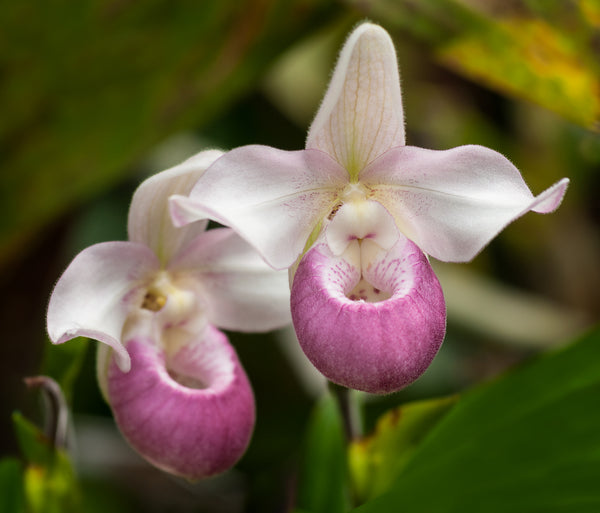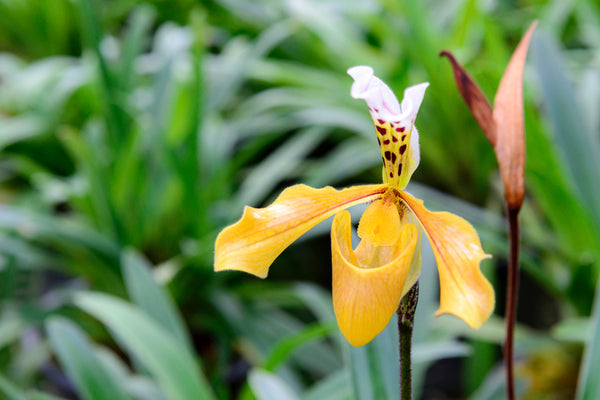Frequently, the name “lady slipper orchids” is used as an umbrella term of sorts to all orchids that belong to the Cypripedioideae subfamily, or in simpler terms for all orchids with slipper-shaped pouches. However, there are many types of lady slipper orchids from different parts of the world, which are all worth knowing more about.
In this article, we’ll delve deeper into the fascinating family of the lady slipper orchids, the specific orchid species from each genus, and practical orchid care and maintenance tips.
Lady Slipper Orchids Facts
Lady slipper orchids are perhaps some of the most uniquely beautiful species in the Orchidaceae family.
Orchids that belong in this family are effortlessly distinguished because of their exotic pouch-shaped flowers, which interestingly functions as a trap for pollinating insects, requiring them to climb up inside the plant’s reproductive parts, deposit pollen, and fertilize the orchid.
- Names: Lady slipper orchid, lady’s slipper orchid, slipper orchid, moccasin (shoe) flower
- Family: Orchidaceae
- Subfamily: Cypripedioideae
- Genera: Cypripedium, Mexipedium, Paphiopedilum, Phragmipedium, and Selenipedium
- Distinct Characteristic: Slipper-shaped lip that resembles a pouch
- Native to: Eurasia and the Americas
- State flower: Minnesota, Showy lady slipper orchid (Cypripedium reginae); New Hampshire, Pink Lady's Slipper, (Cypripedium acaule) and Prince Edward Island, a small province in Canada
These delicate orchids are considered to be some of the most popular and widely illustrated and photographed flowering plants.
According to the Royal Botanical Gardens Kew Science, the earliest record of the lady slipper orchid (Cypripedium calceolus) is a fine watercolor illustration by Conrad Gessner back in 1541. Unfortunately, his work was not published until the 18th Century by Camerarius.
5 Lady Slipper Orchid Genera

iStock
The lady slipper orchid family (Cypripedioideae) is divided into five major genera.
Cypripedium
Cypripedium orchid genus can be found in most parts of North America, Europe, and Asia. There are about 50 temperate and subtropical orchid species under it. All of which are terrestrial (grows on the ground), usually blooms with one or two flowers on a stem that grows from 12 to 24 inches tall.
The most well-known orchid species from this group are the yellow lady’s slipper (C. calceolus) and the pink lady’s slipper (C. acaule), also known as the moccasin flower. See below for a complete list of accepted Cypripedium orchid species.
Paphiopedilum
Thriving in the forests of Southeast Asia, Paphiopedilum is the Asian lady slipper genus. It has about 90 tropical species from parts of the Philippines, Papua New Guinea or Indonesia. Lady slipper orchids from this genus usually have blotchy, green leaves of a leathery texture and large waxy flowers of a variety of colors.
Because of their tropical roots, Paphiopedilum lady slipper orchids are easy to grow and maintain, making them a favorite among orchid enthusiasts. Paphiopedilum Maudiae is especially popular among beginners.
Phragmipedium
Phragmipedium lady slipper orchids are found throughout northern South and Central America. There are 20 orchid species in this genus. Phragmipedium narrow-leaved plants that bloom at least one to six flowers with ribbon-like petals on a stalk that can grow nearly 90 cm (35 inches) tall. Like Paphiopedilum, Phragmipedium orchids are also easy to grow.
Mexipedium
Based on Encylopedia Britannica, Mexipedium consists of a single species, M. xerophyticum, which are endemic to a small region of Oaxaca, Mexico.Initially, the species was described as Phragmipedium xerophyticum by Soto Arenas, Salazar & Hágsater in 1990, but was reclassified and made to have its own genus by Albert & Chase in 1992, after careful DNA analysis.
There are only seven plants in this genus. They grow on dry cliff surfaces and spread by runners. This lady slipper orchid has tiny flowers that are white with a pale pink center. The plant is considered critically endangered.
Selenipedium
There are six species that belong to the Selenipedium genus. They are also native to tropical America. They can grow up to 16 feet tall. Their leaves are folded with the flowers on a spike at the tip of the plant.
S. vanillocarpum has vanilla-scented seedpods. All Selenipedium species are considered endangered or threatened according to the IUCN Red List of Threatened Species.
Are Lady Slipper Orchids Endangered?

Some species of lady orchid species are classified as endangered or threatened in some states and countries. Yes, this makes it illegal for you to pick them from the ground, especially in their wild habitat and on federal lands.
For hundreds of years now, orchids have been sought and extensively collected for many reasons aside from their looks, including medicinal purposes. Orchid poaching, widespread orchid collection, destruction of their natural habitats are some explanations why their numbers have been continuously dwindling.
Add that to the fact that some wild species of lady slipper orchids have special requirements. Take, for example, the Pink lady slipper orchids require Rhizoctonia fungus to thrive. This makes them almost impossible to grow and cultivate when taken out from the wild.
Lady Slipper Orchids in Los Angeles

Lady slipper orchids are extensively distributed worldwide. They grow in both temperate and tropical regions.
The species vary diversely that they can be found in warm countries, such as the Philippines, Indonesia, and Papua New Guinea, to colder and harsher climates like England and the United States. That being said, it’s not impossible to see a lady slipper orchid plant or orchid arrangement in Los Angeles, where it’s always bright and sunny.
Check out local orchidariums and botanical gardens in town. The Arboretum of Los Angeles County, Descanso Gardens, and South Botanic Garden are some of our personal favorites.
However, if you wish to have your own private orchid collection blooming every day just for you, go see our captivating orchid plant arrangements. A stone’s throw away from the prime addresses of the City of Angels, Orchid Republic offers flower delivery anywhere in Los Angeles and Orange County.
How to Take Care of Lady Slipper Orchids
Paphiodelium lady slipper orchids are highly recommended for indoor growing due to its ability to tolerate low-light conditions.As we’ve mentioned above, not all species of lady slipper orchids will survive out of their natural habitat. However, there are diverse species and excellent hybrids that have been developed to stand growing environments even without a greenhouse.
Check out these easy orchid care tips:
-
Light. The lady slipper orchid doesn’t like too much sun nor total darkness. If you’ll put it near a window, make sure it’s protected by the shade of a curtain or window blinds. Use the leaves as an indicator of whether they’re getting enough light. They should be bright green in color.
-
Water. Don’t forget to water your lady slipper orchids once a week. Unlike other orchids, don’t wait for the potting compound to completely dry out before watering again. This orchid plant has no organ for storing water.
- Temperature. There are two types of Paphiodelium lady slipper orchids: the warm and cool variety. If your lady slipper orchid plant has mottled leaves, it’s the warm variety. It’ll do best in warm to intermediate temperatures, somewhere between 21 and 30 degree Celsius throughout the day. The cold varieties, on the other hand, want it a bit colder, around 13 to 18 degree Celsius. A drop in temperature at night would also be good for them and may even encourage them to rebloom after a period of dormancy.
Paphiopedilum lady slipper orchid blooms from late May to early July. Their flowers last between three to six weeks. Although resilient, growing or taking care of lady slipper orchids is a real test of patience. There are some slow-growing varieties that can take anywhere from four to 16 years to bloom.
Cypripedium Orchid Species
The Plant List includes 438 scientific plant names of species rank for the genus Cypripedium. Of these, 59 are accepted species names.

- Cypripedium acaule Aiton
- Cypripedium × alaskanum P.M.Br.
- Cypripedium × andrewsii Fuller
- Cypripedium arietinum R.Br.
- Cypripediumbardolphianum W.Sm. & Farrer
- Cypripedium calceolus L.
- Cypripedium calcicola Schltr.
- Cypripedium californicum A.Gray
- Cypripedium candidum Muhl. ex Willd.
- Cypripedium × catherinae Aver.
- Cypripedium × columbianum Sheviak
- Cypripedium cordigerum D.Don
- Cypripedium daweishanense (S.C.Chen & Z.J.Liu) S.C.Chen & Z.J.Liu
- Cypripedium debile Rchb.f.
- Cypripedium elegans Rchb.f.
- Cypripedium fargesii Franch.
- Cypripedium farreri W.W.Sm.
- Cypripedium fasciculatum Kellogg
- Cypripedium fasciolatum Franch.
- Cypripedium favillianum J. T. Curt.
- Cypripedium flavum P.F.Hunt & Summerh.
- Cypripedium formosanum Hayata
- Cypripedium forrestii P.J.Cribb
- Cypripedium franchetii Rolfe
- Cypripedium guttatum Sw.
- Cypripedium henryi Rolfe
- Cypripedium × herae Ewacha & Sheviak
- Cypripedium himalaicum Rolfe
- Cypripedium irapeanum Lex.
- Cypripedium japonicum Thunb.
- Cypripedium kentuckiense C.F.Reed
- Cypripedium lentiginosum P.J.Cribb & S.C.Chen
- Cypripedium lichiangense S.C.Chen & P.J.Cribb
- Cypripedium ludlowii P.J.Cribb
- Cypripedium macranthos Sw.
- Cypripedium malipoense S.C.Chen & Z.J.Liu
- Cypripedium margaritaceum Franch.
- Cypripedium micranthum Franch.
- Cypripedium molle Lindl.
- Cypripedium montanum Douglas ex Lindl.
- Cypripedium palangshanense Tang & F.T.Wang
- Cypripedium parviflorum Salisb.
- Cypripedium passerinum Richardson
- Cypripedium plectrochilum Franch.
- Cypripedium reginae Walter
- Cypripedium segawae Masam.
- Cypripedium shanxiense S.C.Chen
- Cypripedium sichuanense Perner
- Cypripedium singchii Z.J.Liu & L.J.Chen
- Cypripedium subtropicum S.C.Chen & K.Y.Lang
- Cypripedium taibaiense G.H.Zhu & S.C.Chen
- Cypripedium tibeticum King ex Rolfe
- Cypripedium × ventricosum Sw.
- Cypripedium wardii Rolfe
- Cypripedium × wenqingiae Perner
- Cypripedium wumengense S.C.Chen
- Cypripedium yatabeanum Makino
- Cypripedium yunnanense Franch.
Paphiopedilum Orchid Species
The Plant List includes 388 scientific plant names of species rank for the genus Paphiopedilum. Of these, 119 are accepted species names.

- PaphiopedilumacmodontumM.W.Wood
- PaphiopedilumadductumAsher
- Paphiopedilumappletonianum(Gower)Rolfe
- PaphiopedilumaranianumPetchl.
- Paphiopedilum×areeanumO.Gruss
- Paphiopedilumargus(Rchb.f.)Stein
- PaphiopedilumarmeniacumS.C.Chen&F.Y.Liu
- Paphiopedilum×aspersumAver.
- Paphiopedilumbarbatum(Lindl.)Pfitzer
- PaphiopedilumbarbigerumTang&F.T.Wang
- Paphiopedilumbellatulum(Rchb.f.)Stein
- Paphiopedilumbeyrodtianum(hort.)Guillaumin
- PaphiopedilumbougainvilleanumFowlie
- Paphiopedilumbullenianum(Rchb.f.)Pfitzer
- Paphiopedilum×burbidgei(Rchb.f.)Pfitzer
- Paphiopedilumcallosum(Rchb.f.)Stein
- PaphiopedilumcanhiiAver.&O.Gruss
- Paphiopedilumcharlesworthii(Rolfe)Pfitzer
- Paphiopedilumciliolare(Rchb.f.)Stein
- Paphiopedilumconcolor(Lindl.exBateman)Pfitzer
- PaphiopedilumcornuatumZ.J.Liu,O.Gruss&L.J.Chen
- Paphiopedilum×cribbiiAver.
- Paphiopedilum×dalatenseAver.
- Paphiopedilumdayanum(Lindl.)Stein
- PaphiopedilumdelenatiiGuillaumin
- PaphiopedilumdianthumTang&F.T.Wang
- Paphiopedilum×dixlerianumBraem&Chiron
- Paphiopedilumdruryi(Bedd.)Stein
- PaphiopedilumemersoniiKoop.&P.J.Cribb
- Paphiopedilum×expansumJ.T.Atwood
- Paphiopedilumexul(Ridl.)Rolfe
- Paphiopedilumfairrieanum(Lindl.)Stein
- Paphiopedilum×fanaticumKoop.&N.Haseg.
- PaphiopedilumfowlieiBirk
- Paphiopedilum×frankeanumRolfe
- PaphiopedilumgigantifoliumBraem,M.L.Baker&C.O.Baker
- Paphiopedilumglanduliferum(Blume)Stein
- Paphiopedilum×glanziiO.Gruss&Perner
- PaphiopedilumglaucophyllumJ.J.Sm.
- Paphiopedilumgodefroyae(God.-Leb.)Stein
- PaphiopedilumgratrixianumRolfe
- Paphiopedilum×grussianumH.S.Hua
- PaphiopedilumguangdongenseZ.J.Liu&L.J.Chen
- PaphiopedilumhangianumPerner&O.Gruss
- PaphiopedilumhelenaeAver.
- Paphiopedilumhennisianum(M.W.Wood)Fowlie
- PaphiopedilumhenryanumBraem
- Paphiopedilum×herrmanniiF.Fuchs&H.Reisinger
- Paphiopedilumhirsutissimum(Lindl.exHook.)Stein
- Paphiopedilumhookerae(Rchb.f.)Stein
- Paphiopedilum×huangrongshuanumPetchl.&O.Gruss
- PaphiopediluminamoriiP.J.Cribb&A.L.Lamb
- Paphiopediluminsigne(Wall.exLindl.)Pfitzer
- PaphiopedilumintaniaeCavestro
- Paphiopedilumjavanicum(Reinw.exLindl.)Pfitzer
- Paphiopedilum×kimballianum(Rchb.f.)Rolfe
- PaphiopedilumkolopakingiiFowlie
- Paphiopedilumlawrenceanum(Rchb.f.)Pfitzer
- Paphiopedilumliemianum(Fowlie)K.Karas.&K.Saito
- Paphiopedilum×littleanum(auct.)Rolfe
- Paphiopedilumlowii(Lindl.)Stein
- Paphiopedilum×lushuienseZ.J.Liu&S.C.Chen
- PaphiopedilummalipoenseS.C.Chen&Z.H.Tsi
- Paphiopedilummastersianum(Rchb.f.)Stein
- Paphiopedilum×mattesiiPittenauerexRoeth&O.Gruss
- PaphiopedilummicranthumTang&F.T.Wang
- Paphiopedilum×nitensZ.J.Liu,O.Gruss&L.J.Chen
- Paphiopedilumniveum(Rchb.f.)Stein
- PaphiopedilumooiiKoop.
- Paphiopedilumpapuanum(Ridl.exRendle)L.O.Williams
- Paphiopedilumparishii(Rchb.f.)Stein
- PaphiopedilumparnatanumCavestro
- Paphiopedilum×pereirae(Ridl.)P.Taylor
- Paphiopedilum×petchleungianumO.Gruss
- Paphiopedilumphilippinense(Rchb.f.)Stein
- PaphiopedilumplatyphyllumT.Yukawa
- Paphiopedilum×powelliiChristenson
- Paphiopedilum×pradhaniiPradhan
- PaphiopedilumprimulinumM.W.Wood&P.Taylor
- Paphiopedilumpurpuratum(Lindl.)Stein
- PaphiopedilumqingyongiiZ.J.Liu&L.J.Chen
- PaphiopedilumrandsiiFowlie
- Paphiopedilumrothschildianum(Rchb.f.)Stein
- Paphiopedilumsanderianum(Rchb.f.)Stein
- PaphiopedilumsangiiBraem
- Paphiopedilum×sanjiangianumPetchl.&O.Gruss
- Paphiopedilumschlimii(Rolfe)Pfitzer
- PaphiopedilumschoseriBraem&H.Mohr
- Paphiopedilum×shipwayaeRolfe
- Paphiopedilum×siamense(Rolfe)Rolfe
- Paphiopedilum×sinovillosumZ.J.Liu&S.C.Chen
- Paphiopedilumspicerianum(Rchb.f.)Pfitzer
- Paphiopedilum×spicerovenustumPradhan
- Paphiopedilumstonei(Hook.)Stein
- PaphiopedilumsugiyamanumCavestro
- PaphiopedilumsukhakuliiSchoser&Senghas
- PaphiopedilumsupardiiBraem&Löb
- Paphiopedilumsuperbiens(Rchb.f.)Stein
- PaphiopedilumthaianumIamwir.
- PaphiopedilumtigrinumKoop.&N.Haseg.
- Paphiopedilumtonsum(Rchb.f.)Stein
- PaphiopedilumtranlienianumO.Gruss&Perner
- Paphiopedilum×undulatumZ.J.Liu&S.C.Chen
- PaphiopedilumurbanianumFowlie
- PaphiopedilumvejvarutianumO.Gruss&Roellke
- Paphiopedilumvenustum(Wall.exSims)Pfitzer
- Paphiopedilumvictoria-mariae(SanderexMast.)Rolfe
- Paphiopedilumvictoria-regina(Sander)M.W.Wood
- Paphiopedilum×vietenryanumO.Gruss&Petchl.
- PaphiopedilumvietnamenseO.Gruss&Perner
- Paphiopedilumvillosum(Lindl.)Stein
- PaphiopedilumviolascensSchltr.
- PaphiopedilumwardiiSummerh.
Sources:
Lady's Slipper, Britannica
Kew Science, Plants of the World Online
The Plant List
US Forest Service



Leave a comment